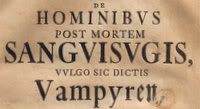
Magia Posthuma is the title of a book written by the Catholic lawyer Karl Ferdinand von Schertz in 1704. In the book von Schertz examines the case of a spectre that roamed about and harmed the living. Several of these cases were known in Moravia where von Schertz published his book, as well as in neighbouring areas. Only two decades later, a similar case was investigated by Austrian officials in North Eastern Serbia. The local people called the spectre a vampire. This incident inspired the deacon Michael Ranft to publish a study on the mastication of the dead. Just a few years later, in 1732, another case of vampirism was investigated in Serbia. Reports of this investigation were published throughout Europe with the consequence that the interest in vampires exploded. Vampires became the topic of numerous learned articles and books. Cases of magia posthuma or vampirism, however, kept occurring. In 1755 empress Maria Theresa aided by her court physician Gerard van Swieten began passing laws against the exhumation and destruction of corpses as well as other acts of superstition. Within decades, however, vampires caught the imagination of poets and authors of gothic fiction. Subsequently popularized by Bram Stoker in his 1897 novel Dracula and numerous movies, vampires have become part of everyday modern mythology, but the historical and cultural background has not yet been fully explored and understood. In fact, the modern conception of the vampiric count bears little or no resemblance to the revenants of the 18th century, and several modern books rather obscure than enlighten us on the early modern European revenants and vampires.
The article was published on Magia Posthuma

No comments:
Post a Comment